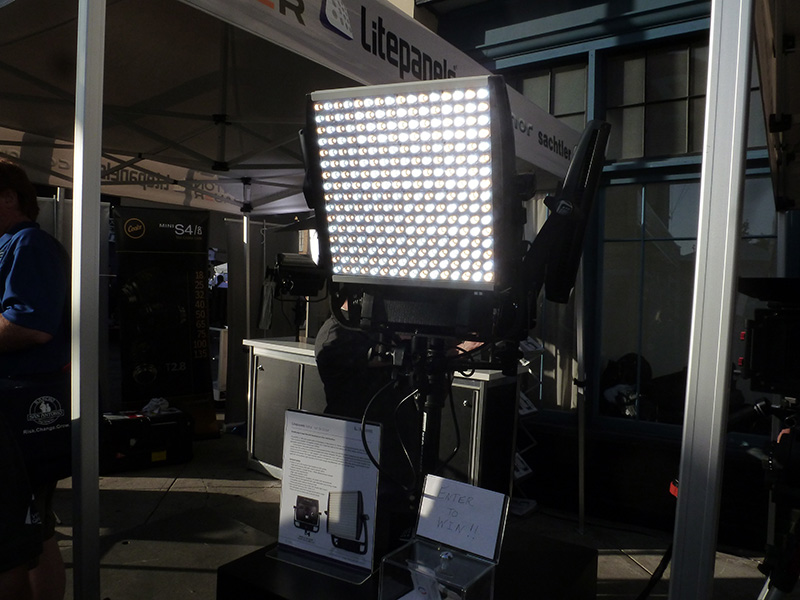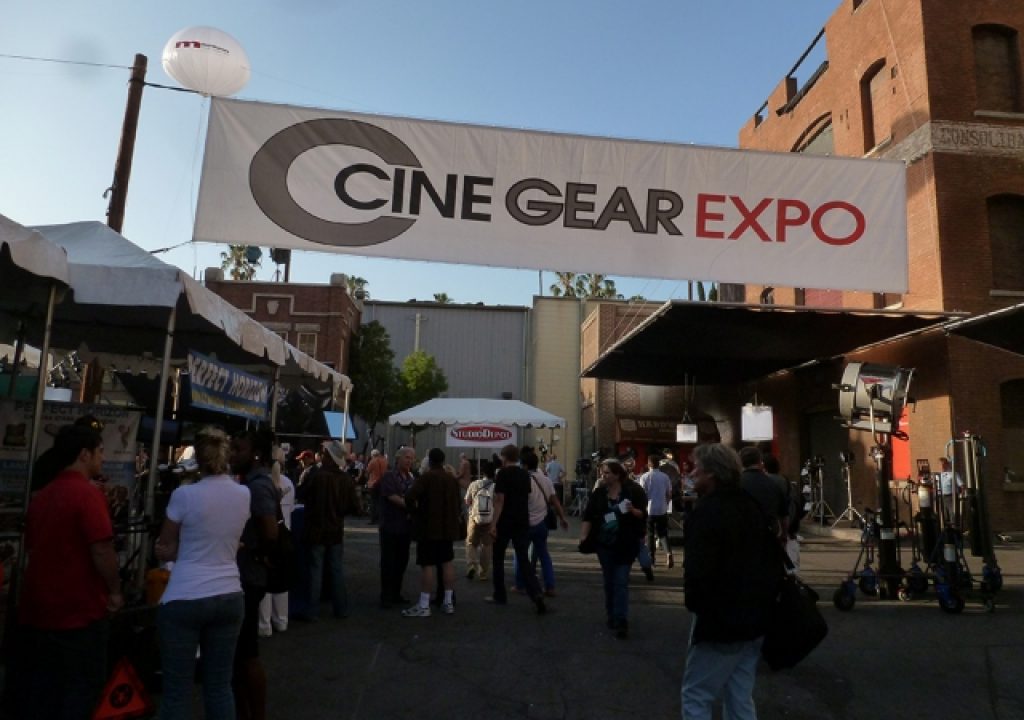Matt Jeppsen said it best in his Cine Gear 2013 Wrap Up… the reason folks like Cine Gear is because unlike NAB, it’s smaller, more intimate, and a lot more cine-focused. It’s a much different show, and the size of the event allows you to get a better handle on the tools and technology that are being showcased.
Cine Gear 2014 was no different in those terms, and it was once again held on the lot of Paramount Studios in Los Angeles. Even though the event is fairly close to NAB, plenty of the exhibitors had new things to show off, and the setting here allows you to actually see and touch some of what you might have missed out on at NAB.
We’ll be back for Day 2, but below are a few of the exhibitor highlights from Day 1. Click to the next page to see more pictures from the show.
Litepanels

The news about Litepanels ASTRA 1×1 Bi-Color Fixture went out earlier this week, but the product was front and center at their booth at Cine Gear. Ali Ahmadi, Senior Product Manager for Litepanels, was excited to talk about the product as it is built on the legacy of the company’s original 1×1 fixture.
“It has a thick aluminum plate in the core of the light with an aluminum extrusion at the top and the bottom that makes up the ibeam structure, and then everything else attaches to it. We did that because that’s the core of this modular concept that we have”, Ahmadi said. “When the fan is on you have 4x the intensity of the old 1×1. When the fan is off, its twice as bright as the old 1×1. That modular approach is carried through the whole design of the unit.”
The ASTRA 1×1 is already being used in numerous Hollywood productions, and Ahmadi couldn’t even get specific because of the NDA’s they are under. The modular-based ASTRA system currently includes a field replaceable fan module and the optional RJ45 DMX module with an LCD menu and function display. Additional wired and wireless communication modules are currently in development and will continue to be introduced to future proof the fixtures as new technologies become available.
“We designed the original 1×1 and were the first to market, so we’ve gotten a lot of feedback, and all of that went into the designing of this fixture,” Ahmadi said. “That’s why there are so many small detail solutions that are practical. That’s what makes a difference. We wanted to make a practical light in the application.”
ARRI / Dolby
At Cine Gear, attendees were able to handle the ARRI AMIRA and check out their most recent lighting products. Matt Jeppsen talked with ARRI about the AMIRA at NAB and also got the details around the L5 LED Fresnel, but it was far easier to see and handle the products here. This gave us the opportunity to talk with Robert Carroll, Senior Director at Dolby, about the power of better pixels in the ARRI booth.
A comparison was setup which showed off the differences between the displays. This picture doesn't do it justice, but you could see how the lower display was washed out and almost grainy in comparison.
“We talk about faster pixels and higher resolution, but the third dimension of this that hasn’t been talked about is better pixels,” Carroll said. “It’s about making the content we can already capture and display better by providing that dynamic range. And that’s what we’re doing here.”
SmallHD
The story behind how SmallHD came to be is an interesting one. It was started by a group of young filmmakers that recognized a need in the industry for a High Definition on-camera monitor solution. After winning several Doritos Superbowl commercial contests, the small group of friends from Cary, North Carolina, built the world's smallest true HD field monitor and SmallHD was born.
At Cine Gear 2014, their focus was around their new color-grading and look-up table color management system on the DP7 Pro. “We’ve added firmware that’s going to be coming out in about a week that allows you to take raw footage and convert it in the monitor to a nice looking color graded image in real time,” said Weston Philips, SmallHD CEO.
He showed attendees a split screen view of the raw footage and color graded version of the footage, and the difference was obviously significant. “I can make these modifications real time, so it allows any DP or DIT to be able to take the raw footage and modify it to exactly what they want to see in post,” he told us. “It allows people to stay on the same page on-set. “Instead of the client looking at this flat image on an external monitor, you can send the look-up table down stream to a secondary monitor, so you’re able to satisfy the client and ensure they’re looking at something that’s representative of what a finished product would be,” Philips said.
Light Iron
Another company that made news this week was Light Iron, as they announced Live Play 3 this week. The new Live Play 3 boasts an intuitive interface, powerful metadata sorting, and cloud distribution of dailies.
“We really tried to bring something totally new to a section of the market that’s used to how things work”, said Michael Cioni, CEO at Light Iron. “We think we’ve perfected what other people have been using, and at least massively improved what the dailies review and cloud collaboration experience can offer.”
“The truth is, most dailies systems come from a legacy based DVD type of infrastructure. It’s very general, and that’s not how people want to work,” Cioni told us. “They don’t want to think of it like a tape or DVD. They want each clip to be its own world. So we approached it in terms of how people want to do this in 2015 versus how they did it in 2006. We’re able to borrow concepts that people are familiar with, like tagging, so that when people use Live Play 3 a lot of what they’re doing feels intuitive and automatic.”
G-Tech
Scott Simmons talked with Greg Crosby from G-Tech about their new products at NAB this year but they also had some new ones for Cine Gear. We followed up with Greg to find out those details.
“At Cine Gear we’ve announced a couple new additions to our product portfolio,” he said. “One of those is actually kind of an additional drive module that we have for our Evolution Series. So it’s kind of a refresher for the Evolution Series. We have this ecosystem that we’ve created to be a highly flexible, scalable storage solution. It optimizes the way people are transferring and distributing content. The main component of that is our G-Dock EV with Thunderbolt. It’s a dual Thunderbolt port and will accept a variety of different hard drive modules. At NAB we announced an SSD version of the module, and here we’re announcing it’s bigger brother from a capacity standpoint. We have up to 2TB of capacity with transfer rates of about 225 MB per second.”
The G-DRIVE ev 220, G-RAID with Removable Drives and their Studio Line were all showcased at the event.
Pictor Vision
Pictorvision™ is a world leading supplier of stabilized camera systems to the broadcast, entertainment and commercial sectors, and their 36K multi camera array was one of the pieces of equipment that got people to stop in their tracks and take a closer look.
“The 36K multi camera array is for visual effects plate-shots,” said Tom Hallman, Pictorvision President. “It's 6 RED Dragons. Six times six is 36K. It’s 140 degree wide field of view by 60 degree high. The idea is you shoot very wide with very high resolution plate shots and then in post production you stitch them together and you have this giant palette to then pan-and-scan and frame for your visual effects work.”
The ability to completely stabilize a large payload is something no one else in the industry can do as effectively. It’s a completely different way to approach plate shots.
“It’s a gyro-stabilized head which allows for the stitching to be batch processed which makes it that much easier for the visual effects guys,” Hallman said. “All the cameras are perfectly steady, and that makes it much better than guys who had been forced to simply bolt cameras to boards and deal with cameras that move in different ways.”
There's more to come on Day 2, but click here to check out more pictures from Cine Gear 2014
Page 2


